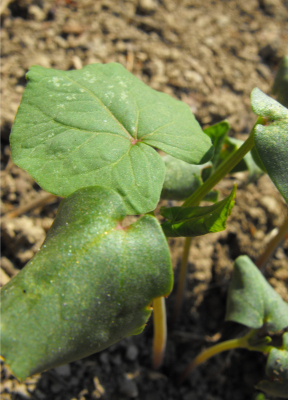
No-till cover crop
 I'm
searching for a cover crop that:
I'm
searching for a cover crop that:
- is reliably winter-killed in zone 6 (meaning that I don't have to till it in or pull it out)
- is non-leguminous (so that I'll get lots of organic matter rather than lots of nitrogen)
- will survive in our problem spots --- dense, clayey soil with a
high water table
So far, buckwheat and oats seem to be my top
contenders. I've been slipping buckwheat into gaps in my rotation
this month, beds where spring crops have been pulled out with nothing
to take their place for at least six weeks. Next month, I'll
plant oats in empty beds.
If all goes as planned,
our cover crops will turn into a heavy mulch that will partially or
entirely decompose in time for spring planting. It's even
possible that the buckwheat will die in five or six weeks when I mow it
down at bloom time, allowing me to plant garlic under the green manure
a few weeks later.
Do you have a favorite
no-till cover crop? I'm open to any and all suggestions since
this year is our first trial.
Want more in-depth information? Browse through our books.
Or explore more posts by date or by subject.
About us: Anna Hess and Mark Hamilton spent over a decade living self-sufficiently in the mountains of Virginia before moving north to start over from scratch in the foothills of Ohio. They've experimented with permaculture, no-till gardening, trailersteading, home-based microbusinesses and much more, writing about their adventures in both blogs and books.
Want to be notified when new comments are posted on this page? Click on the RSS button after you add a comment to subscribe to the comment feed, or simply check the box beside "email replies to me" while writing your comment.

I've been reading this post and realized I'm in need of the same thing. I came across this table of non-leguminous, non hardy (WK means winter-kill), cover crops in a Rodale Institute article. I hope this HTML table turns out to be readable. Besides buckwheat there are four other possibilities you may not have heard of.
Buckwheat Comments: Short life cycle, residues decay rapidly; can become weed by reseeding.
Sorghum-sudan hybrid Comments: Mow at 3-4 ft to promote deep rooting allelopathy may inhibit some crops
Foxtail millet(6) Comments: Fast growing, drought tolerant, no hard seed, thus low potential to become weed
Pearl millet(6) Comments: Hard to mow-kill, very tall
Japanese millet(6) Comments: Quick maturing (45 days)
More info here. The table would not paste in legibly so some important info is at the bottom of this link that is not above. http://newfarm.rodaleinstitute.org/features/0104/no-till/chart.shtml
Thanks so much for that extra information! You might also be interested in reading the cover crop section of our blog. Since making this post, we've put in a year of experimentation and have decided that:
*Buckwheat doesn't like our clay soil and doesn't make much biomass for us, but does reliably mow kill and rot in quickly. An okay quick summer cover crop.
*Oats love our soil and died quite well over the winter, producing a heavy mulch. Perfect fall cover crop! However, in the spring, I had to resort to hand-weeding them --- not so good there.
*Oilseed radishes had amazing weed-suppressing properties and also winter-killed reliably when planted in the fall. Another great cover crop.
And then there are the ones I won't be trying again, but I won't list them all here...